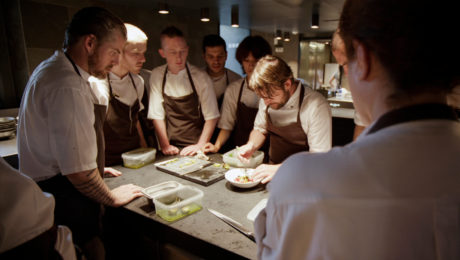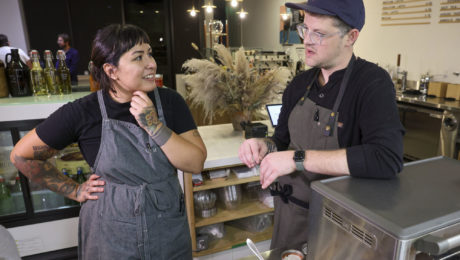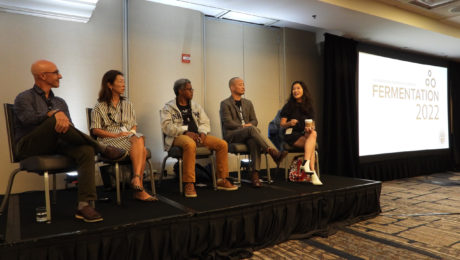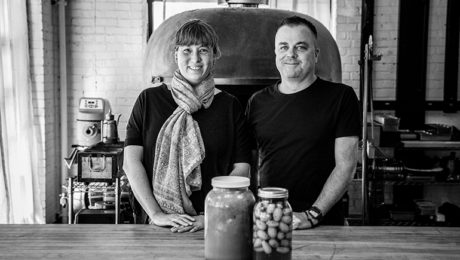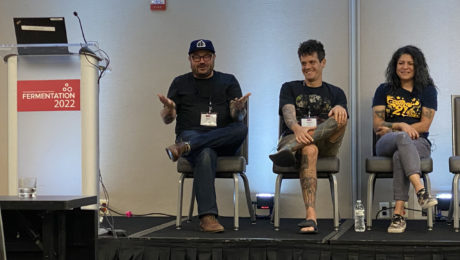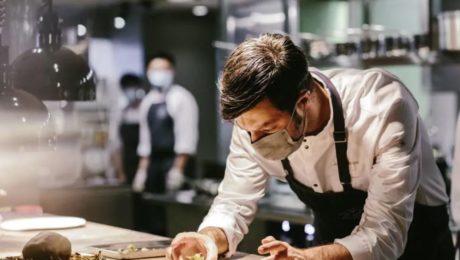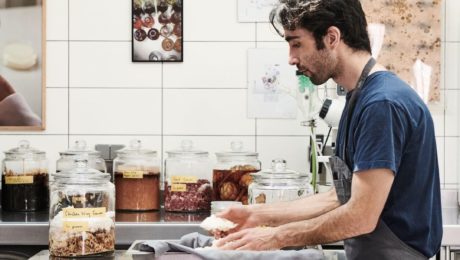Bringing Injera to U.S. Diners
A California-based Ethiopian chef is making some creative takeout offerings. Serkaddis Alemu of Santa Barbara Ethiopian restaurant Petit Valentien now sells DIY injera kits, for customers to create the fermented flatbread at home.
“Don’t call it bread; don’t call it crȇpes: Injera is injera,” Alemu says (pictured with her husband and daughters). “With fermentation, you really can’t cut corners.”
Injera is a spongy, sour, pancake-like flatbread. It is made of teff flour, a nutrient-dense flour that grows in the highlands of Ethiopia. Injera is a staple in Ethiopia, and TFA predicts it’s poised to become a popular fermented food in the U.S.
The $49 kit contains an instructional guide, video links, one pound of ivory teff, one pound of brown teff and Alemu’s mother dough.
Alemu says slowing down will be the biggest challenge for some home cooks making their own injera. Fermentation of injera takes between one and six days, depending on the desired flavor outcome. She hopes the kit will help inspire others to ferment.
Read more (Santa Barbara Independent)
- Published in Food & Flavor
Noma Announces End of Restaurant; Hires for Food Lab
Noma – the New Nordic restaurant that inspired the restaurant fermentation movement – announced it will be closing in 2024, reopening as a food lab. This reiteration (owner René Redzepi calls it Noma 3.0) will focus on developing new dishes and products for Noma Projects, Noma’s e-commerce, CPG operation.
Within days of the news, Noma announced the hire of Arielle Johnson, PhD, as Noma Projects’ Science Director. Johnson, a flavor scientist, food chemist and gastronomy researcher, co-founded the Noma Fermentation Lab in 2014.
Since first opening two decades ago, Noma has been named one of the world’s best restaurants. The announcement shocked the restaurant industry as Noma is seemingly at the top of their game. Noma redefined fine dining – meals at Noma were largely local, Nordic ingredients turned into artistically beautiful and culinarily unique dishes.
“The style of fine dining that Noma helped create and promote around the globe — wildly innovative, labor-intensive and vastly expensive — may be undergoing a sustainability crisis,” writes the New York Times.
Redzepi himself says the long hours and fair compensation for the large team “is not workable.” Noma came under fire for their stagiaire program, the term for unpaid restaurant interns. Noma started paying their interns in October 2022.
“We have to completely rethink the industry,” he told the Times. “This is simply too hard, and we have to work in a different way.”
“Fine dining is at a crossroads, and there have to be huge changes,” he said. “The whole industry realizes that, but they do not know how it’s going to come out.”
Read more (New York Times)
- Published in Business, Food & Flavor
Slow Burn Serves Travelling Ferments
Hear the origin story of traveling restaurant Slow Burn and you’ll wonder what’s the meaning behind the name. Chefs practice zero waste through slow cooking methods, fermenting, preserving and dehydrating scraps to use as an ingredient in the next sustainable meal. The chefs founded Slow Burn after feeling frustrated with the traditional restaurant industry, from the exhausting grind to the amount of food waste.
Slow Burn will travel through California’s coast this fall and winter, then head to multiple cities in Canada. Husband-and-wife duo Andy Doubrava and Tiffani Ortiz drive to each location towing a “trailer full of their carefully packed jars of fermented sauces, pickled produce and whatever else they’ve smoked and preserved, then travel from kitchen to kitchen. Whatever isn’t utilized at one event will appear on the next menu, or the next — sometimes as an oil, sometimes a relish, sometimes as part of a dessert in the name of creative waste mitigation, and hopefully, building awareness and community around it.”
Of their food cost, 65% goes towards what’s plated, while 35% goes toward future meals. In addition to creating new ingredients out of food scraps, they’re using waste to compost, dye merchandise and create soaps from the kitchen grease.
Unsure how guests would respond to a roaming, sustainable restaurant, Doubrava and Ortiz were surprised at the amount of tickets purchased through the 2022 – and the amount of invitations from chefs around the world.
“It’s really hard to put what we do in a box,” Ortiz told the Los Angeles Times. “I had to put ‘international food’ on our Tock page because how do you explain to people the weird s— we’re doing sometimes? It doesn’t sound good when you say that we’re fermenting rhubarb, but it’s kind of one of those things where when they’re here, they understand.”
Read more (Los Angeles Times)
- Published in Food & Flavor
Traditions of Fermentation, Cultural Appropriation & Diversity
Cooking isn’t limited to only making the dishes of one’s ethnicity. The cultural identity of that food becomes murky when it gets transactional. Commercializing a food without respecting and honoring its history and tradition is inauthentic, damning to immigrant producers and threatens to erase traditional foods.
“Someone with more power or dominance, they can create their own kimchi – that doesn’t have any resonance to its tradition – and get it on the shelves of Wal-Mart and make it commercially successful. I don’t have that opportunity because I’m a woman, I’m Korean, I’m a minority and I’m just trying to tell the story about kimchi in my way,” says Lauryn Chun, founder and CEO of Mother-in-Laws kimchi. Chun’s kimchi comes from her mother’s recipe used in the family restaurant in California, Jang Mo Jip. “It’s my heritage of food that I enjoy sharing with Americans.”
Chun’s experience is similar to many BIPOC producers. It’s difficult for minority producers to compete with the white-owned brands that often have more money to launch a food company and receive preferential treatment by retailers for store placement.
“When you turn it into a business and you’re profiting as a company, we need to be more sensitive and more deliberate in how we give credit to people,” adds Robert Danhi, chef and co-founder of Flavor360 Solutions (and a TFA Advisory Board member)
Speakers discussed the wide range of issues related to traditional foods in a panel during TFA’s conference FERMENTATION 2022 titled “Traditions of Fermentation, Cultural Appropriation and Diversity.” Panelists included Chun, Danhi, Beverly Kim (chef and owner of restaurants Parachute and Wherewithall in Chicago), Kheedim Oh (founder of Mama O’s Premium Kimchi and TFA Advisory Board member) and Ismail Samad (founder of Loiter and Wake Robin Foods). The discussion was moderated by Josephine Wee (assistant professor at Penn State University and a TFA Advisory Board member).
Do Cultures Own Their Foods?
“There’s appropriate appropriation,” says Oh, whose Brooklyn-based kimchi brand is also based off the recipe of Oh’s mother, a Korean American. “Some of these brands, is what they’re making even kimchi? Kimchi is such a popular buzzword now. But it’s an unfair advantage when you’re competing with me and Lauryn to get your kimchi on the shelf and it’s very loosely kimchi.”
Brands are coming to retail with condiments labeled kimchi that are far from the traditional Korean condiments. They’re skimping on ingredients, like not using traditional Napa cabbage and opting for cheaper produce varieties. Though there’s hundreds of versions of traditional kimchi, some brands are veering too far to gain sales (Oh joked about a raspberry cheesecake kimchi).
“We need to change the narrative from appropriate to appreciation, celebration and preservation,” Wee adds.
Should a culture own a fermented food? Like Koreans just selling kimchi? The panel didn’t agree with that notion. But Samad points out a culture’s food is taken away from them when it’s exploited.
Through his nonprofit Loiter, Samad tackles the effects of systemic racial and economic injustice. He’s helping the residents of East Cleveland by developing successful, community-owned businesses – like Wake Robin Foods, a fermented food brand Samad purchased. Wake Robin will create ferments using produce from local, urban farmers.
“It’s black owned by black farmers so we can get some black dollars circulating in our culinary economy so they can have some freaking version of reparations for what has happened,” Samad says. “For me this is straight financial, who gets the opportunity to scale up.”
Samad says there’s an entire food system of African fermented foods “not being appropriated or appreciated in the U.S.” He hopes to disrupt the market.
“There’s an opportunity to introduce products that are owned by own by us, and by us I mean the African Diaspora,” he says.
Nuances in International Dining
Many American diners, though, are “still even at the elementary level of understanding the differences between different cultures in a diaspora,” says Kim, a former Top Contestant. “Asian cuisine is not just one monolithic cuisine.”
Some pan-Asian restaurants sell sushi (Japan) alongside kimchi (Korea) and pad thai (Vietnam), a “mish mash” of foods from different Asian countries. “We have to “continuously dig deeper to show there are nuances between the cultures,” she says.
It can be a difficult concept for chefs, too, who are trained in primarily French cuisine at culinary school. When Kim went through culinary school, a short quarter was focused on global foods, “the rest is basically Fresh cuisine.”
Ethnic food — especially Asian fare— the food is often stereotyped as cheap, “it’s a bamboo ceiling that you can’t charge high prices,” Kim says. Western diners often don’t take into account the differences in quality of ingredients or the creativity, care and time in cooking a dish. “We’ve been seen as cheaper because we’re Asian, so people question why our prices are so high.”
Chun, who grew up helping in the family’s Korean restaurant, began Mother-in-Law’s kimchi questioning why kimchi wasn’t in the ranks of specialty craft foods like fine cheese.
“From the perspective of western fermented foods, from cheeses to wines to craft beers, those are the only things people are willing to spend their money on,” Chun says. She adds she felt very proud to be the first kimchi in specialty grocery store chain Dean and Deluca.
In retail, many international food brands get placed in the ethnic aisle. But why does a sauce from an international region get placed in the ethnic aisle while spaghetti is placed in the sauces aisle?
“I’m torn over the concept of that existing,” Oh says. “We’ve been subjugated to the ethnic aisle aka the global ghetto where there’s no reason for it except the fact that I’m Korean.”
Cultural Regulatory Bias
Are there conflicts between tradition and science? Panelists shared how some health regulators don’t understand cultural ferments, causing batches of fermented food to be deemed unsafe for human consumption and thrown out.
Kim attempted to start a wholesale kimchi brand during the brand. Studies prove kimchi is made safely at a pH range of 4.2-4.5, but the regulator from the health department was told Kim legally had to keep kimchi under pH levels 3.3 to keep it safe.
“There’s so much confusion around it, I had to reach out to food scientists to clarify it, and we don’t want to get in trouble,” Kim says. She ended up cancelling the brand because securing regulatory approval was so difficult.
Oh adds: “I think there’s a big cultural bias when it comes to fermented foods. In the U.S., it’s either the food is 100% clean scrubbed and pasteurized or it’s not – and the not is dangerous and dirty. Where fermented foods predates modern electricity and modern science, there’s a reason why it’s safe because it works out that it’s a very safe food because, through the lactic acid fermentation, it lowers the pH and that helps preserve the food.”
- Published in Business, Food & Flavor
Organization Necessary for Creativity at Noma
Beautiful photos of the “farm to table mecca” Noma graced the pages of this month’s Harper’s Bazaar, with an accompanying article interviewing chef-owner Rene Redezepi and R&D head Mette Brink Søberg. The Nordic restaurant has come to redefine modern fine dining as using local and seasonal ingredients.
When Noma started, Redzepi says the challenge was how to serve Nordic food year-round, even in the harsh climate of Copenhagen.
“I thought to myself, why are we trying to serve a tasting menu with a little bit of everything as opposed to what’s really good when it’s available?” Redzepi says.
Noma’s tasting menu is divided into three cycles – plant-based in the summer, wild game and foraged mushrooms in fall and local fishermen’s hal in the winter. Noma’s test kitchen is in a greenhouse next to the garden, “we are very connected to the seasons and can pick flowers and leaves to use on the menu right at our doorstep,” Søberg says.
Redzepi says necessary to their creativity is organization. They make a list of ingredients and techniques they’d like to employ, make deadlines and use pictures as a frame of reference. “We keep meticulous records of finished dishes,” he says.
“In the beginning of the creative process, it is important to allow ourselves to spend time working on those ideas that might at first glance seem impossible or ridiculous, because even if they might not end up on the menu, they could lead to something that we would have never come across if we hadn’t sacrificed the time,” Søberg adds. “Often the most innovative and original elements on the menu have many weeks and sometimes months of work behind them.
Read more (Harper’s Bazaar)
- Published in Food & Flavor
Reducing Waste, Cost with Fermentation
After hiring a fermentation expert to help reduce food waste, Id Est Hospitality Group saw their food cost drop from 32% to 22%. Kelly Whitaker, founder and chef, hired Mara King, fermentation specialist (both pictured), to pursue a zero waste model in the group’s different restaurants. Whitaker points out he doesn’t like using the term “waste” but “other products” instead.
King is chef, co-founder of fermented food business Ozuké, educator and producer of the YouTube series “People’s Republic of Fermentation.” She notes in a climate like Boulder, Colo., preserving food is key.
“As a fermenter, one of the first things Kelly wanted me to dive into was seasonality,” said King. “We live in Colorado and it has a short growing season compared to other places in the world.”
King began a large-scale preservation project at Id Est Hospitality Group, using the produce from local farmers to fuel ideas. For example, she made a vinegar using the discarded peels of 200 persimmons and a hot sauce with more than 90 pounds of 100 types of chiles, with the chiles prepared in different ways (preserved, roasted, frozen or dried).
Read more (Restaurant Hospitality)
- Published in Business, Food & Flavor
Upcycling & Zero Waste
Fermentation is a powerful culinary tool for upcycling.
During the Upcycling and Zero Waste session at FERMENTATION 2022, six fermentationists with diverse backgrounds in the industry shared how they’re using fermentation to reduce food waste.
“As a chef, we are constantly chasing these depths of flavors and things that you can’t get in regular cooking applications or techniques. Fermentation opened up a whole new world of flavor,” says Jessica Alonzo, a fermentation specialist and owner of small batch ferments company Native Ferments in Texas. “We were looking to enhance diner’s experience and fermentation did that.”
The panelists from all over the world included: Alonzo, Jeremy Kean (chef/owner of Brassica Kitchen), Mac Krol (CEO/founder of Mac Ferments), Richard Preiss (cofounder and brewing scientist at Escarpment Labs), Michelle Ruiz (CEO/co-founder of Hyfé Foods) and Ismail Samad (founder of Loiter and Wake Robin Foods).
Aiding farmers
Alonzo consults with area restaurants to build unique larders. She helped create the fermentation and whole food utilization program at Petra and the Beast as the former sous chef. Fermenting the restaurant byproducts helped the restaurant eliminate food scraps, cut down on food cost and partner with farmers.
Up to 40% of food grown in America is thrown away, according to the U.S. Department of Agriculture.
“I got into zero waste and upcycling through relationships with farmers, seeing how much was wasted at the farm level,” says Samad, who also co-founded and was executive chef at The Gleanery in Vermont. “The Gleanery existed for the last 12 years to provide a very clear safety net for farmers not selling their stuff at the farmers market.
Samad admits he didn’t know much about fermentation when he first started, “We just knew we didn’t want to keep wasting food.” By fermenting the kitchen scraps, “we’re making sacrifices that big food won’t do.”
Exploring Science
At a scientific level, Preiss at Escarpment is looking at upcycling “through a microbiologist lens.” Preiss said he began upcycling when he realized the current food system is unsustainable in a linear economy.
“There’s a lot of opportunity for creating circular food economies to not only reduce waste but help every single stakeholder involved in this process make more money, pay people more, create jobs, be more profitable and ultimately stay open as part of the sustainability discussion,” he says.
Restaurants are often leading upcycling and fermentation conversations – “many people know about fermentation because of restaurants.” But Preiss says the craft beer industry is becoming a leader in the upcycling movement because, today, they’re in many neighborhoods. “They have a really cool platform to communicate new ideas around food innovation.”
Escarpment is exploring interesting ways to use spent grains from beer. Currently, they’ve created a way to make seasonings. Brewers use those seasonings in their menu dishes, a novelty that gets customers excited about pairing a beer with a dish seasoned with that craft brew’s spent grain.
“There’s a lot of opportunity in that grain, there’s still a lot of nutritional quality,” Preiss says. “Through fermentation, we unlock new possibilities.”
Hyfé Foods is also utilizing waste. They’re taking the discarded sugar water (typically used in beverage production) and, through fermentation, repurposing it in mycelium flour. Mycelium is a type of mushroom. Hyfé’s proprietary biotechnology makes a protein-rich, low carb mycelium flour in a carbon-neutral, affordable process.
“Often when a manufacturer makes a product, the lifecycle being considered ends at the door. We’re often not measuring the greenhouse gas emission impact, the wasted sugar water – that goes down the drain,” says Ruiz. Food manufacturers pay a hefty fee to get rid of waste water. “We’re really excited about the position that upcycling puts us in, not only from a cost standpoint but also we’re creating a really nutritious, low cost food.”
Upcycling Barriers
Upcycling is not without its challenges.
Kroll at Mac Ferments specializes in koji. He recently created shoyu made with used coffee grounds, koji, water and salt – an excellent choice, he says, for a restaurant that likely throws out pounds of coffee grounds at the end of the night.
“It is obviously nice to create added volume from leftovers, it tightens the whole supply chain,” Kroll says. “But also there are risks of potentially overproducing just to create extra waste. You have to be careful what you’re doing because you’re dealing with enzymes – and we don’t see microbes.”
Fermentation, he says, should be utilized for quality, not quantity.
“If every dish has something fermented, a regular customer might come home starving,” Kroll adds.
Preiss sees collaboration as a major challenge because creating a circular, upcycled system involves multiple stakeholders sharing their waste products.
“Upcycling can’t be done in a silo, you need collaboration, and getting people that have the different pieces of the puzzle together to make it happen is the biggest challenge,” he says.
Samad, meanwhile, says scaling is a hurdle. “There are opportunities for investments around upcycling, but there’s a ceiling where this culture or ethos can be sustained.”
Educating customers, too, can be tricky. The public consuming the product or dish needs to understand what is upcycled. Servers, as the mouthpiece to diners, must taste and know a dish to communicate its elements. Chefs must detail to servers where ingredients were sourced, how long the food was aged and what was cross utilized, Alonzo says.
Panelists said the public is excited about the new taste experiences with upcycled food – but they’re also more curious about the science behind it.
“Folks come into Brassica for that fermentation program and are so interested and hungry for that knowledge from the science community,” Kean says. “And then theres folks that just want to eat and say ‘What the fuck was that?’ I think it’s a mixture between the two.”
“The education around all this stuff is growing,” he adds. “I see the culinary world and science world getting closer and closer together and I think that’s the right direction.”
- Published in Food & Flavor, Science
Fermented Flavor Development in Restaurants
In the last decade, fermentation has taken center stage at fine dining restaurants. How do owners and chefs develop and maintain a fermentation program for their kitchen?
An all-star team of U.S. chef-owners at FERMENTATION 2022 shared their successes and failures in developing fermentation-focused kitchens. Speakers included: Sean Brock of Audrey Restaurant in Nashville, Jeremy Kean of Brassica Kitchen in Boston and Misti Norris of Petra & the Beast in Dallas. Jori Jayne Emde, chef, educator and owner of Corner Office in Taos, New Mexico, moderated the discussion.
The chefs all focus on whole food utilization, aiming to eliminate food waste in flavor-packed dishes. Fermentation is key. Food scraps that would otherwise be thrown out – stems from produce, coffee grounds or animal bits – are fermented and reinvented in flavorful, unique dishes.
“By reusing the product in different manipulations over and over again, this type of program can really develop branding potential over time,” Emde says. “The process of bringing several lives to one product puts one’s fingerprint on the cuisine, so the restaurant expresses its own terroir.”
In-House Fermentation
Core to developing a restaurant fermentation program is assigning someone to oversee the process. Who will track the start dates, monitor pH levels and control filtration?
Emde, who formerly ran Fish & Game in New York’s Hudson Valley, quickly learned at the restaurant “you can’t just have a multitude of chefs handling it…ferments are alive and require being nurtured and cared for.”
Brock agrees, noting some restaurants have their chef de cuisine or sous-chef head up fermentation efforts. “But the reality is they have so much to do already.”
“It’s critical to have someone dedicated to the program,” Brock says. “When you’re having to build such a renegade operation, the biggest challenges are keeping up with inventory and monitoring each ferment.”
Audrey hired a fermentation specialist in 2014, Elliot Silber. He has a chemistry degree and “understands fermentation at a completely different level,” Brock says.
“I still can’t believe we have someone in charge of fermentation,” he adds. “Now, we put fewer things on the plate with a bigger impact. I get to finally produce food I would consider minimalist.”
Brassica Kitchen takes a different approach to their fermentation program – a food map.
“We’ve been running fermentation forward cuisine for about 10 years and, in that 10 years, we’ve gone through a lot failure and chaos and really kind of developing things as we go, to changing the menu everyday to coming in long before service to staying long after to doing inventory and plug and play with them. We hit a wall,” Kean says. “We’ve found ourselves looking at over 100 misos and going ‘What the fuck do we do with this?’”
The kitchen’s food map is a shared document where the chefs outline how to utilize every byproduct. It’s been Brassica’s most effective menu-planning solution. “This food map has solved a lot of the problems and created a box of creativity we can really thrive in,” Kean says.
Health Department Woes
When Brock launched his first fermentation program at Charleston’s Husk restaurant in 2010, “ironically our biggest challenge was the health department,” Brock said. “They would make us throw food away.”
Health department officials – many who had no idea what fermentation was or its inherent safety – would immediately issue violations for any food sitting on a counter at room temperature, a normal process for fermenting foods or beverages. Husk maintained a makeshift lab on the roof of the restaurant hidden from officials, and staff had a code word for when the health department would come to the restaurant.
Norris recalled instances where inspectors would pour bleach on their fermented food products or throw their meat in the trash.
“It’s hard because we’ve taken the time to learn and be knowledgeable about how to keep these foods safe. And then someone comes in who is supposed to be keeping people safe but has no knowledge of food and we’re trying to make food healthier and keep it more dynamic and sustainable,” Norris says. “It’s frustrating when you put so much of yourself and your philogosphy into the food.”
Audience Acceptance
Today – as fermentation is featured regularly in food, health and science news – diners are eager to eat unique, fermented dishes. This hasn’t always been the case. Even today,diners need to trust a restaurant before they will buy dishes experimenting with fermentation. Norris notes, when Petra and the Beast first opened, fermentation was not a food trend in Texas. Residents had not grown up with a food culture of eating and preserving wild food.
“It definitely did not happen overnight,” she says. “It took a lot of educating and reassuring people that these things are delicious and they are a little uncommon, a little different. It’s something that took time and effort to understand what we were doing with full utilization and sustainability.”
Kean, too, said it took time at Brassica.
“We’d be using all these (fermented) products and I wouldn’t even mention it on the menus,” he said. “The trust was built over all these years and until we could really start speaking on it.”
Eliminating food waste was mentioned as fermentation’s gateway of acceptance for diners.
Food Waste into Food
Brock says the goal at Audrey is to find 10 uses for every seasonal, region-specific ingredient. For example, last year they received candy roaster squash from a local farm and served it in different forms in dishes throughout the fall season. But they also fermented it and will be serving it again this year.
“We don’t create dishes and then get the ingredients,” Brock says, “the ingredient fuels the dish.”
The kitchen at Audrey is full of glass-encased ferments, each organized by parts of the tongue.
Brassica has found success in utilizing food waste by creating delicious dishes that are “black holes for the extra stuff” Kean says. For example, they serve a fried rice dish using sticky rice from the day before with fermented vegetables. The dish is popular, low cost and “encourages little things that can be vehicles in a dish.”
“It’s been inspiring over the years to find a use for the byproducts, then the byproducts become so important that you have to then buy the byproduct,” he says. “It’s happened to us over and over again.”
Petra and the Beast focuses on whole animal utilization. By being sustainable and “hyper-seasonal,” Norris says, Petra is “creating food with the most depth, creating food that’s not just one note.”
“I ask myself and the team ‘Well, what should we do with it? Is there a better use for it? Is there a sour brine or can we make a salt out of it and use it on that same vegetable next season?’” Norris says. “If you really truly understand why a flavor profile is developing in a certain way, you look at everything else differently.”
- Published in Food & Flavor
Chefs Turn to Fish Sauce for Flavor Punch
Fish sauce has been used for centuries as a umami “flavor bomb” for dishes. An article in British Post Magazine highlights how chefs throughout the world use regional variations of fish sauce – from Vietnamese nuoc mam, Malaysian belacan, Filipino bagoong and Italian colatura.
“Fermentation has been an integral part of many traditional food cultures to develop flavourful foodstuffs,” says Ana San Gabriel, who specializes in umami taste receptors and physiology at food and biotech company Ajinomoto.
San Gabriel details that fish sauce is made from the proteins (myosin, troponin and titin) from the flesh of fish that are broken into umami compounds (peptides and free glutamate) through salting and fermentation.
Belacan is a staple of Malaysia’s coastal cuisine. It’s a shrimp paste used in curries and sambals.
“Belacan has a deep history and heritage in Malaysia, and for many locals it evokes fond memories of family gathered together to make it from scratch,” says Jasper Chow, the executive sous chef at One&Only Desaru Coast, a luxury beachfront resort in Malaysia. “Making belacan is a delicate process that reminds us of the simple yet sophisticated methods of cooking that survive even until today.”
In Vietnam, nuoc mam is made in the southern island of Phu Quoc. It can be made from fish, shrimp or crab.
“As a dip, it highlights the sweetness and clears the greasiness of meat and deep-fried bites. It gives an exciting flavor to, yet never buries, the beautiful natural taste of fresh rolls,” says Pham Van Nhuong, the sous chef in the kitchen at Vietnam’s Tempus Fugit. “As a seasoning, unlike salt, it adds to braises, stews and even stir-fries a vigorous flavor and a signature scent.”
Bagoong in the Philippines is made from fish or krill.
“Bagoong is one of the building blocks of umami, or linamnam, in Philippine cuisine. Sometimes it’s used as a condiment or flavor for an existing dish, sometimes it will be the actual component or basic building block of a dish – like the dish binagoongan, which literally means ‘you used bagoong’,” says chef Jordy Navarra, chef at Toyo in Manila.
Colatura di alici is Italy’s modern version of garum, made from salted and fermented anchovies along Italy’s Amalfi Coast.
“We use colatura as a subtle addition to many dishes and in doing so have nearly completely removed the use of sea salt for sauces and purées,” says Antimo Maria Merone (pictured), chef at Neapolitan restaurant Estro in Hong Kong. “This allows us to precisely reach the level of sapidity by adding a certain percentage of fish sauce to the preparations that lack natural umami.”
Read more (Post Magazine)
- Published in Food & Flavor
Jason White Leaves Noma Amidst Its “Biggest Transformation”
Jason White has resigned as director of fermentation for Noma. He will be CEO and co-founder of a yet-to-be-announced biotechnology company in the United States. White tells The Fermentation Association that he will share details of his new project in the coming weeks.
Regarded as one of the best restaurants in the world, Noma earned their third Michelin star last year.
This summer, Noma owner Rene Redzepi announced that 2023 – the 20th anniversary of Noma – will be “our final year with Noma as we know it.”
“We have a plan, and I can’t wait to share more with you later this year, but for now, know that big changes are happening,” Redzepi wrote on Instagram, adding it’s “our biggest transformation so far…We’ve been laying some new foundational stones so we can continue to grow as an organization for the next 20 years.”
The staff had planned to take off this fall to travel to an undisclosed (but rumored to be in Mérida, Mexico) international location to learn some new cooking techniques and open a pop-up restaurant. But both the travel and pop-up have been postponed until spring 2023 due to ongoing travel restrictions related to the Covid-19 pandemic.
Last year Noma launched Noma Projects, a direct-to-consumer product line aimed at generating more revenue for the restaurant. In June, Bloomberg reported the restaurant was unprofitable in 2021 – the first time in four years – losing 1.69 million krone (~$225,000) after recording a small profit the prior year. Noma also received 10.9 million krone (~$1.45 million) from the Danish government in Covid-19 relief.
Noma’s previous head of the fermentation lab, David Zilber, also left the restaurant for a job in the biotech industry. He is a food scientist at Chr. Hansen.
White, who spoke at the 2nd international Food Innovation Conference this summer (produced by the Gottlieb Duttweiler Institute (GDI)), said fermentation is motivating scientists to listen to gastronomers.
“There’s going to be a huge exchange in this two-way road that we’re living in. Innovation in flavor coming from gastronomy and innovation coming from a high-level biotechnology, they are going to be harmonious,” White said. “We’re going to be able to create this infrastructure and community of people who have the same goal, and the same goal is going to be the wellness of our planet.”
- Published in Business


